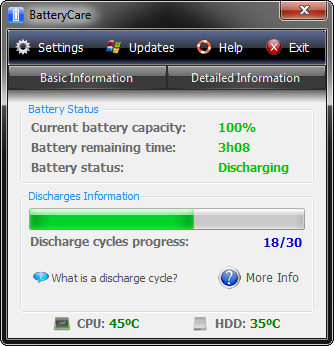Een hoop aannames... settings en omstandigheden.
Als je accu management "slim genoeg" is hoef je gewoonweg niets te doen en is alles goed geregeld.
De beste info over Lithium - ion/ -fe /- po vind je overigens doorgaans in de modelbouw wereld.
Die misbruiken de accu's gigantisch (auto trekt zomaar 200 amp) zonder management, en laden met intelligente laders...De winnaar is meestal degene die zijn packs het best op orde heeft...
Ontladen van een Li-Ion is geen probleem, te diep ontladen < 2,5 v wel. Daar kunnen ze echt niet tegen , ze gaan dan in "sleep" modus of gewoon stuk. Een veilige marge (20%) aanhouden is dus raadzaam Veel laptop accu's bestaan uit een bundel 18650 lithium ion cellen. Vaak zit er onderop de cel een printplaatje (bescherming) verborgen onder de minpool.
zie :
http://i01.i.aliimg.com/w...CB-For-LED-Flashlight.jpg
Bij lipo's zijn die er niet standaard en wordt er bij modelbouwauto's een verklikker op de accu aangesloten die gaat gillen als 1 van de cellen onder de 3.1 volt komt.
Overladen is ook slecht, hij kan gaan gassen en uiteindelijk in vlammen uitbarsten. Vandaar het beschermprintje per cel. en zodoende zijn er weinig ongelukken met Lithium Ion batterijen.
Kleine beetjes ontladen en telkens direct laden is ook niet goed, het beste wordt hij gewoon gebruikt.
Dat is helaas bij laptops niet het geval, die staan meestal op 100% continu aan de lader EN in een omgeving met een hoge niet ideale temp en daar kunnen ze ook al niet tegen (scheelt snel 20% capaciteit).
Moraal : niet de grenzen opzoeken.... te vol / te leeg / te warm
Waarom cyclen :
There's a set cut-off minimum a lithium-ion can be allowed to discharge to, it's about 3.0V/cell, of a nominal 3.7V and a fully charged 4.1V. If it discharges below 3.0V per cell, the cell will lose capacity catastrophically as it de-polarises. By 2.0 V/cell, the cell has no appreciable capacity left at all.
So every lithium-ion has a built in hard-cut which triggers at about 3.0V/cell. However, the device you're using also has a soft-cut, usually about 3.4V/cell. This represents about 10% of the cell's total usable capacity which never will be used, but the battery's controller has to plain guess where it is, as the device never allows the battery to hit the 3.0V/cell "zero point". So in time the "0%" point as reported to the device creeps up and creeps up until the battery has very little run-time remaining, even though its actual wear level is quite low.
When this happens, on a laptop (non-Mac, they do not have the ability to run regardless of battery level) you turn off all power management, tell it to "Do nothing" at the low battery and critical battery points and just let it run until it hard-isolates the battery. You might be surprised how long it lasts with 0% battery remaining. Then leave the device off and charge it fully. In one quite hilarious discharge, I ran a netbook for two and half hours on 0% battery, the battery wear level dropped from 68% to 9% on the next charge.
This is a full battery recalibrate and can usually salvage 30 min to one hour of laptop runtime from an older battery.
 Versie 0.9.30.0 van BatteryCare is uitgekomen. Dit programma geeft informatie over de accu in een laptop en kan helpen bij het optimale gebruik ervan. Zo wordt aangeraden om de accu na dertig keer laden een keer volledig te laten leeglopen. BatteryCare kan precies aangeven wanneer die tijd is aangebroken. Het programma kan verder Aero en andere zaken die veel energie gebruiken, automatisch uitschakelen als de accu wordt gebruikt en deze weer inschakelen als de adapter wordt aangesloten. BatteryCare is gratis, huist in de system tray en gebruikt zeer weinig resources. Nieuw in deze release is de mogelijkheid om een alarm af te laten gaan wanneer de temperatuur van de processor of harde schijf boven een bepaalde waarde uitkomt.
Versie 0.9.30.0 van BatteryCare is uitgekomen. Dit programma geeft informatie over de accu in een laptop en kan helpen bij het optimale gebruik ervan. Zo wordt aangeraden om de accu na dertig keer laden een keer volledig te laten leeglopen. BatteryCare kan precies aangeven wanneer die tijd is aangebroken. Het programma kan verder Aero en andere zaken die veel energie gebruiken, automatisch uitschakelen als de accu wordt gebruikt en deze weer inschakelen als de adapter wordt aangesloten. BatteryCare is gratis, huist in de system tray en gebruikt zeer weinig resources. Nieuw in deze release is de mogelijkheid om een alarm af te laten gaan wanneer de temperatuur van de processor of harde schijf boven een bepaalde waarde uitkomt.

:strip_exif()/i/1283719842.png?f=thumbmedium)